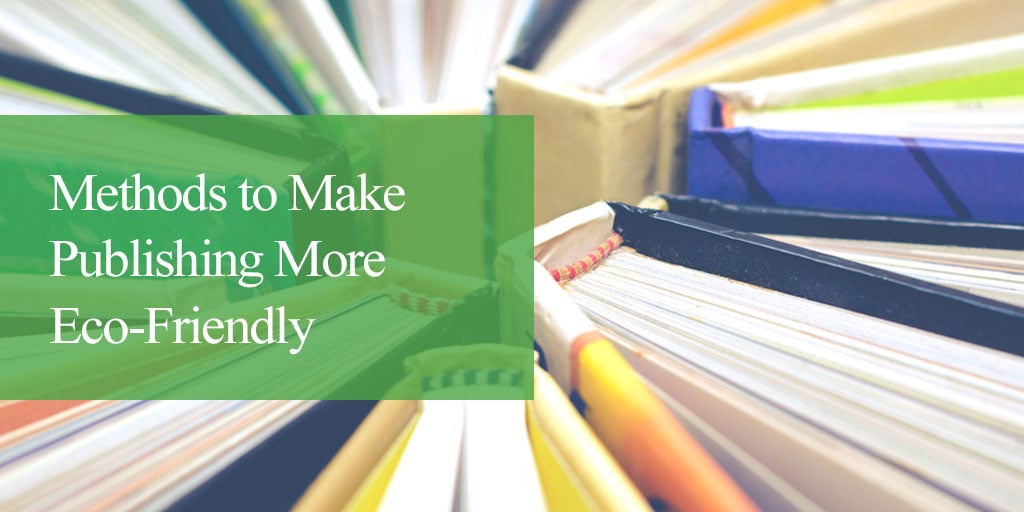Eco-friendliness is an evolving conversation in many industries, including publishing. Over the years, paper mills, publishers, printers, and authors have attempted to minimize the environmental impact of publishing books without reducing the quality.
Traditional publishing consumes an enormous amount of resources, namely paper. Even with ebooks increasing in popularity, paper production and use account for a large portion of carbon emissions. Paper requires trees to be grown and felled, the resources to process the fibers into paper, and the energy to ship the volumes to and from the printers.
In the U.S., paper production is the third-highest industry in the consumption of fossil fuels and the second-largest emitter of greenhouse gasses, according to an article from Portland State University. So what can be done to reduce the environmental impact of publishing?
Becoming Carbon Neutral in Publishing
Currently, there isn’t a way to truly produce carbon-neutral paper products, but that doesn’t mean manufacturers can’t aim to produce low-carbon products with the goal of going carbon-neutral in the future.
Here are some methods the publishing, printing, bookbinding, and bookselling industries are implementing to reduce emissions.
Recycled Paper
There has been a lot of debate about the benefits of recycled paper. It’s generally accepted that using recycled paper reduces climate impact. When the process of making virgin paper and recycled paper are compared side by side, every ton of 100% recycled fiber copy paper saves 17 million BTUs. That is enough energy to power the average U.S. home for over two months.
This sounds great, but how the paper is made and moved factors into its impact as well. For example, a paper mill in Arizona recycles old newspapers to create 100% post-consumer paper. Surprisingly, this facility’s emissions are 18 times higher than a paper mill producing virgin paper in Quebec.
So what’s the difference?
The Quebec manufacturer gets its electricity through hydropower and moves its products using rail. These factors add up, making the Quebec plant produce fewer emissions than the recycled paper counterpart. It sounds counterintuitive that virgin paper could have fewer emissions than recycled paper, but the manufacturing method creates a huge impact. While recycled paper can be a way to reduce emissions, the manufacturing process also needs to be taken into account.
Recycled Cover Board
It is essential to consider the outside just as much as the inside regarding books and eco-friendliness. Some manufacturers create book covers from 100 percent recycled fiber. These covers provide excellent warp resistance and dimensional stability. Recycled covers are optional for books that can receive a lot of wear and tear, such as scientific annuals, college textbooks, premium trade books, library-bound books, and photo and scrapbooks.
Lighter Paper
Reducing the amount of fiber that goes into each book also lowers the weight of the end product. During the manufacturing process, paper is a lot like dough. It can be rolled into a thinner sheet. Some paper manufacturers are switching from using a 45-pound base weight as their primary stock to a 40-pound base paper.
This is a win-win for the environment and publishing companies. It’s easier and more cost-effective to transport books that weigh less. While some texts will still want higher-quality paper for archival purposes, thinner paper can reduce emissions for standard printing.
Biodiversity in Paper
You might have noticed some books have “a mix of paper for responsible sources” notice on them. The Forest Stewardship Council (FSC) has one of the best-known certifications for paper products that are sourced from sustainably managed forests. The FSC isn’t perfect, but many large publishing companies use FSC certification to avoid the worst of deforestation.
Plastic-Free Adhesives
Reducing emissions means thinking about every aspect of publishing, including how the books are bound. Over the years, books have been bound in a variety of ways. Gelatin glue has been a staple in the industry for years. It comes in and out of vogue and is back again because it’s plastic-free and comes from a recycled source.
Gelatin glue is a protein-based adhesive. In the 1970s, manufacturers started using recycled pharmaceutical and nutritional gelatin from soft and hard capsules to create gelatin glue. Additional ingredients, including water, Epsom salts, corn sugar, and glycerin, make gelatin glue non-toxic, recyclable, and biodegradable. While there is more than one way to glue a book together, using gelatin adhesives is a good approach to help reduce the environmental impact of bookbinding.
Print On Demand
Print-on-demand (POD) technology can prevent excess waste by only printing a book after it’s ordered. By adopting POD and better marketing techniques, publishers can focus on reducing print runs and avoid overselling the potential of the book.
POD allows distributors to invest less in a large print run, making returns less complex. This printing method can also help ease the pressure of inventory space, benefiting both publishers and booksellers.
Many printers in the industry view POD as an expensive investment upfront. However, if we consider the amount of money lost in a print run of a book that ends up being returned to the distributor’s warehouse in 6 months and then pulped, POD looks like a more profitable option. Producing less also means fewer emissions. Using POD would make book returns less frequent too, as booksellers would only be selling the books requested.
Playing Our Part in the Future of Publishing
Reducing emissions means using a multi-pronged approach. There isn’t a single solution to making publishing greener. At LD Davis, our gelatin adhesive is one of many ways to improve a product's sustainability. Contact us if you want to know more about making bookbinding more eco-friendly.







